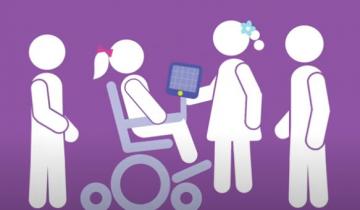The purpose of this study was to pilot an intervention of a sport-based youth development program modified for accessibility for children and adolescents with movement challenges, with the goal of community-based running participation using running frames.
CPF Executive Director Rachel Byrne and Chris Modlesky, PhD discuss exercise, fitness, research, research funding and his current research.

Our educational series continues with this virtual event featuring a multi-disciplinary panel discussion on exercise and physical activity and its impacts on spasticity and function.
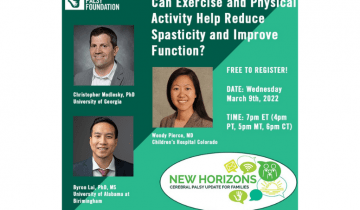
The Winter Paralympics is a great opportunity to learn about the many adaptive recreational and competitive sports for individuals with cerebral palsy.
CPF Executive Director Rachel Byrne and Jocelyn Cohen, Vice President of Communications and Engagement at Cerebral Palsy Alliance Research Foundation discuss collaboration in research.

CPF Executive Director Rachel Byrne and physical therapist, Jennifer Jezequel, PT, discuss exercise and fitness for children with Cerebral Palsy.

CPF Executive Director Rachel Byrne and Byron Lai, PhD, discuss exercise and fitness for individuals with Cerebral Palsy.

CPF Executive Director Rachel Byrne and speech therapist, Kristen Allison, PhD, CCC-SLP discuss communication and Cerebral Palsy.

We got the diagnosis of Cerebral Palsy when Lelia was 18 months. I was really happy, as we didn’t know what was wrong with her before then. She had low tone. She couldn’t roll over. She couldn’t sit up. Of course she didn’t walk. The diagnosis gave it a name, something I could work with, and I became a kind of vigilante mother, determined to get the best care for my daughter.
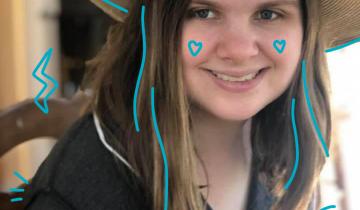
Wouldn’t it be great if inclusive, accessible playgrounds were in every community for all to enjoy? Although progress is being made in certain areas, there is a lot more work to be done to literally level the playing field and help communities and designers understand what makes an inclusive accessible playground and why they are important for people of all abilities.
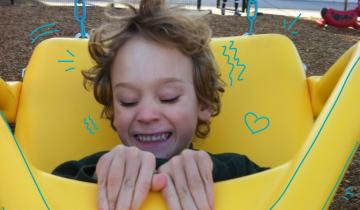
Almost all of us can vividly conjure up an episode of being bullied that occurred in our own lives. Hopefully, fewer of us will have memories of being the bully. These experiences and remembrances often are formative, perceived as hurtful, and can have a long term impact on our health and well-being. For me the memory of being the center of attention in a negative way never quite fades, but with age, the perspective changes to a challenge.
Individuals with Cerebral Palsy frequently participate in Adaptive Sports and Therapeutic Recreation programs. Though there are often many similarities in programs and frequently the terms are used interchangeably, there are differences that are highlighted here.
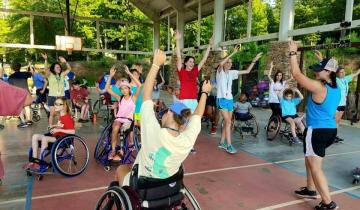
Frame Running is becoming increasingly popular as a recreational and competitive sport for individuals with cerebral palsy across all GMFCS levels. Tune in to learn more!

In this episode, Mary Gannotti, PhD, PT, discusses fitness, health and function across the lifespan for individuals with cerebral palsy.

There are multiple factors that impact bone health, including birth weight, nutrition, medications for seizures and/or reflux, genetics, and physical activity. Targeted exercise to improve bone health in childhood can be sustained into adulthood, and childhood is the best time to promote bone health.

There are many kinds of physical activities that people with cerebral palsy can participate in – for both ambulatory people as well those who use various mobility devices. Knowing just what activities are right for whom can be tough, this article helps to sort that out.

The RAD RaceRunner is a three-wheeled running bike with chest support. It is designed for children and adults with balance or mobility challenges to achieve their exercising goals -be it recreation, competition, or rehabilitation.
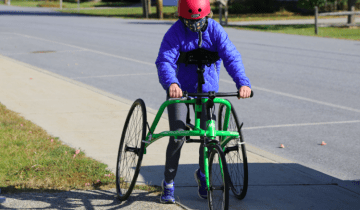
Around the age of six all children are going off to school. Children move from explorative play, which is fairly informal to a much more formal day. That can be a lengthy day and it's quite structured. There are a lot of challenges faced by children with cerebral palsy throughout the school year.
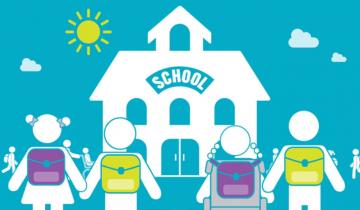
There are a couple of key things to think about in helping children and adolescents make the transition into young adulthood and independence. One of those things is called mastery motivation and we can see mastery motivation early in life. It's the ability to persist in the face of challenge. If you're growing up with a disability, it can be harder to do things. If you are not challenged, if the environment is not set up correctly, or if you don't have the resources, then you start to feel that you can't master certain kinds of tasks.

We all have different towns and we all have different things that we do in the course of the day. It may be that the student is a great artist or a great writer. When it comes to assistive technology we have to think about what is going to give that student the ability to do what they love without having to see roadblocks and go, "I can't do that”. There are so many tools out there, whether it's a communication app, a video app, a math tool. With assistive technology you are not making the student into what you want them to be.

When you use alternate means of communication it can be really frustrating to go out in community. It is hard to know whether people are understanding you and whether they will take the time to listen. A lot of times it's hard for people to admit that they're not always comfortable with a device or a wheelchair or person who does things differently. So the more we can expose and educate people the better off we all will be. When we talk about acceptance, we're not just talking about people in society accepting people with disabilities. We're also talking about people with disabilities who are using alternate means of communication and how difficult it is for them to be out in the community.

In order to get a good education, children need to access the curriculum. That's at the heart of their education. Some of the key challenges of getting students both their education and access to their voice in the class is simply understanding. Preparation for the student with disabilities is key. We have to foster success. We have to build a sense of success in the beginning. That starts with understanding the abilities of that student.
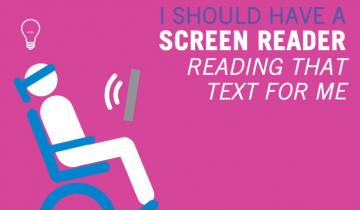
It's really essential to understand how brain function works to really tap into how learners learn.
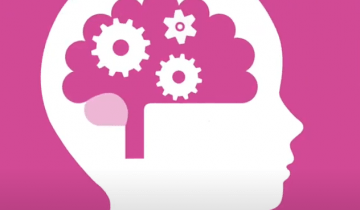
Many of our products today have accessibility supports in them to the extent where we don't have to purchase anything else. It's already in there. Your phone, your tablet, your smart home devices. If you're going to look for these features on your devices, you can start in your settings. There should be something in there that says accessibility. Go in there, see what's available. The manufacturers have done a really nice job of describing these features right within the settings to give you a sense of what they're going to do.


